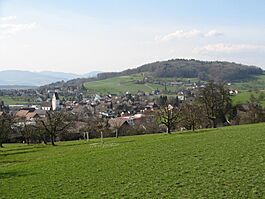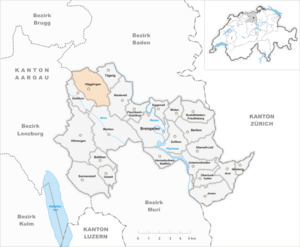Hägglingen facts for kids
Quick facts for kids
Hägglingen
|
||
|---|---|---|
 |
||
|
||
| Country | Switzerland | |
| Canton | Aargau | |
| District | Bremgarten | |
| Area | ||
| • Total | 7.75 km2 (2.99 sq mi) | |
| Elevation | 472 m (1,549 ft) | |
| Population
(Dec 2020 )
|
||
| • Total | 2,437 | |
| • Density | 314.45/km2 (814.4/sq mi) | |
| Postal code |
5607
|
|
| Surrounded by | Dottikon, Mägenwil, Niederwil, Othmarsingen, Tägerig, Wohlen, Wohlenschwil | |
Hägglingen is a small town, also called a municipality, in Switzerland. It is located in the canton of Aargau, within the Bremgarten district.
Contents
History of Hägglingen
The first signs of people living in Hägglingen come from ancient burial mounds. These mounds were built during the Hallstatt period, a time long ago. There are also signs that small groups of people lived here during the Roman era.
Hägglingen was first officially mentioned in the year 1036. At that time, a powerful count named Ulrich von Lenzburg gave the church and a farm in "Hekelingen" to a place called Beromünster. Later, in 1045, Emperor Henry III also mentioned the village of "Hackelingen."
Over time, the control of Hägglingen changed hands many times. It went from the Lenzburg family to the Kyburgs, and then to the Lords of Hallwyl in 1273. The Habsburgs ruled the area until the Swiss took over Aargau in 1415. Hägglingen became an independent town from 1435 to 1712.
In 1609, the town created rules for how people should use the forests and manage water. This showed that Hägglingen was acting like a truly independent town. Sadly, between 1611 and 1613, about 150 people died from a serious illness called the plague. In 1656, soldiers from Bern attacked the town, burning some parts of it.
The local church, St. Michael, was built between 1457 and 1466. Only its tower and a special part called the choir are from the original building. The church was made bigger in 1638–39 and fixed up in 1739. In 1951, old paintings from the late Gothic period were found in the choir. These paintings were made around 1480–90.
For a long time, people in Hägglingen mostly worked in farming and small businesses. In the 1700s, making things from straw, like hats or baskets, became a big industry. This "straw plaiting" grew even more important in the 1800s. Because the nearest train station was a bit far away, new factories didn't come to Hägglingen very quickly. By 2003, many small and medium-sized businesses, especially those working with plastics, offered about 520 jobs in the town.
Geography of Hägglingen
Hägglingen covers an area of about 7.8 square kilometers (or 3 square miles). A large part of this land, about 56.8%, is used for farming. Forests cover 32.9% of the area. The remaining 10.3% is where buildings and roads are located.
The town is located in the Bremgarten district. It sits in a raised valley next to the Bünztales river. Hägglingen includes the main village and two smaller settlements called Igelweid and Rüti. Rüti joined Hägglingen in 1823.
Hägglingen's Coat of Arms
The coat of arms for Hägglingen has a special design. It shows a golden flax comb with silver spikes on a blue background. A flax comb is a tool used to prepare flax, a plant used to make linen fabric.
People in Hägglingen
Hägglingen has a population of about 2,500 people. Around 13% of the people living here are from other countries. Most people in Hägglingen speak German, which is 92.4% of the population. Albanian and Serbo-Croatian are the next most common languages.
Looking at the ages of people in Hägglingen:
- About 10.5% are children aged 0 to 9 years old.
- Around 12.1% are teenagers aged 10 to 19.
- About 11.1% are young adults aged 20 to 29.
- Around 15.1% are between 30 and 39.
- About 18.2% are between 40 and 49.
- Around 13.3% are between 50 and 59.
- About 9.3% are between 60 and 69.
- Around 6.6% are between 70 and 79.
- About 3.3% are between 80 and 89.
- A small number, 0.6%, are 90 years old or older.
In Hägglingen, about 62.9% of homes are owned by the people who live in them. This means they don't pay rent. The average number of people living in each home is about 2.53. In 2008, there were 506 single-family homes in the town.
In the 2007 national election, the most popular political party was the SVP. They received 39% of the votes. Other popular parties included the CVP (21.2%), the SP (13.7%), and the FDP (12%).
Most people in Switzerland are well-educated. In Hägglingen, about 73.8% of adults (aged 25 to 64) have finished high school or gone on to higher education, like a university. In the 2008/2009 school year, 193 students attended primary school and 46 students attended secondary school in Hägglingen.
Here's how the population of Hägglingen has changed over time:
| Historical population | ||
|---|---|---|
| Year | Pop. | ±% |
| 1850 | 1,535 | — |
| 1900 | 1,415 | −7.8% |
| 1950 | 1,514 | +7.0% |
| 2000 | 1,990 | +31.4% |
Economy in Hägglingen
In 2007, the unemployment rate in Hägglingen was low, at 1.58%. This means most people who wanted to work had jobs.
The town's economy is divided into three main parts:
- Primary sector: This includes jobs like farming. In 2005, 128 people worked in this area.
- Secondary sector: This involves manufacturing and industry. There were 436 people working in this sector.
- Tertiary sector: This covers services, like shops, offices, and healthcare. About 174 people worked in this area.
Many people who live in Hägglingen travel to other towns for work. In 2000, about 70.2% of residents worked outside Hägglingen. At the same time, 347 people came into Hägglingen to work. Most people, 54.3%, used a private car to get to work. About 7.4% used public transportation.
Religion in Hägglingen
Based on a survey from 2000, most people in Hägglingen are Roman Catholic, making up 57.7% of the population. The next largest group, 23.3%, belongs to the Swiss Reformed Church. A very small number of people belong to the Christian Catholic faith.
See also
 In Spanish: Hägglingen para niños
In Spanish: Hägglingen para niños






